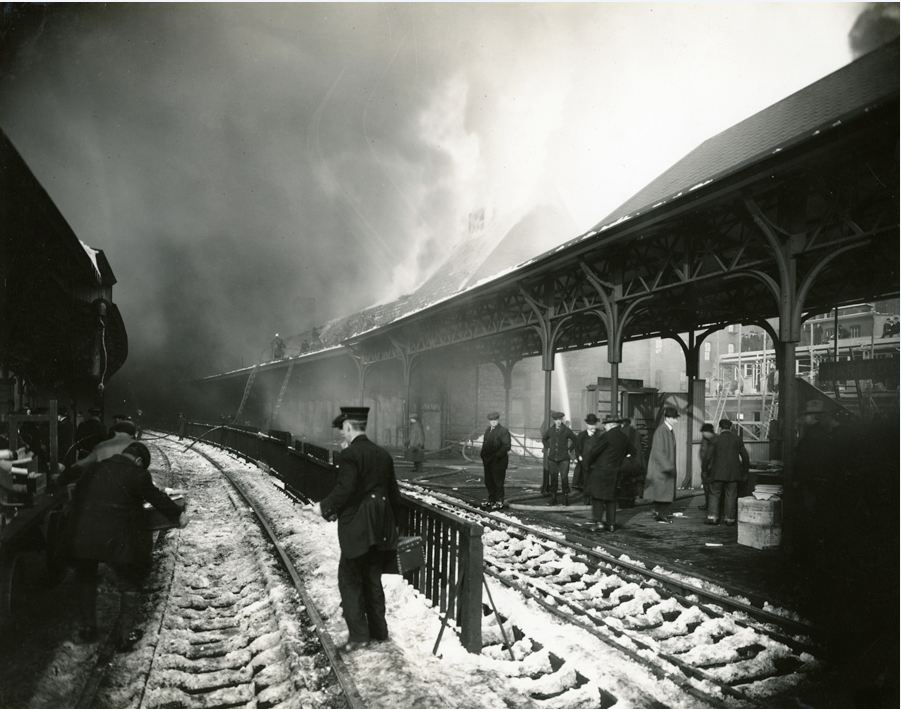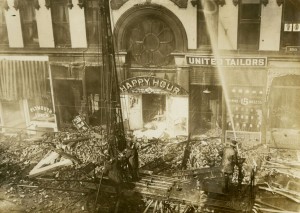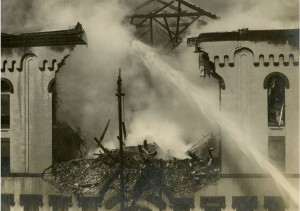By Bethany Gallant for Your Public Media
Hartford’s Union Station, completed in 1889, acts as downtown’s western boundary and is the visual transition point between the business district and the residential neighborhood of Asylum Hill. The station originally operated for multiple railways including the Hartford and New Haven Railroad, Hartford and Connecticut Valley Railroad, Central New England Railway, and the New York and New England Railroad.

Union Station: Ladder work on Union Place. Photograph, 1914. Firemen on ladders combat smoke pouring from the roof – Connecticut Historical Society, Horace B. Clark Collection
On February 21, 1914, a cold, snow-covered afternoon, a fire broke out at the north end of the station, in an area which held passenger baggage as well as freight and mail to be transported. Deep snow in the streets delayed the fire trucks rushing to the scene. A series of small explosions occurred while firefighters were battling the blaze, presumably from gas provisions in storage. Local newspapers reported that firefighter William Kane was injured from the resulting blasts. Two larger explosions lifted off a large portion of the roof and caused the waiting room ceiling to crumble. The newspaper stands and ticket and other offices were completely crushed by the collapsing roof. Images of the building after the fire reveal debris and rubble everywhere and fire ravaged walls. The estimated monetary loss at the time was $250,000. The structure was rebuilt and still runs and operates to this day. The current building was listed on the National Register of Historic Places in 1975.
The Allyn Hall Fire, commonly referred to as the “Auditorium Fire” or the “Happy Hour Fire,” occurred less than a week later on February 26, 1914. The auditorium, which opened in 1856, hosted many political gatherings as well as theatrical events. The building also housed a restaurant, offices, and a movie theater, which had begun showing “moving pictures” in 1909.
The first fire alarm was sounded at 12:21 pm. The fire originated in the rear of the store of the G.W. Fuller Co. on the ground floor. Fire trucks and firefighters struggled through snow to respond to the fire, which quickly spread to the north end of the building. Parts of the upper floors fell into the street, littering rubble and debris. Smoke poured from the windows and the roof of the commercial block containing the theater and other stores. The fire department’s new water tower was used to combat the height of the fire, reducing the flames considerably. Following the fire, the historic old building was so badly damaged it had to be demolished. Today the XL Center, which occupies the same block on Asylum Street, offers sporting events, concerts, and other forms of entertainment.
Bethany Gallant, a volunteer at the Connecticut Historical Society, is Exhibition Coordinator for Eastern Connecticut State University’s Visual Arts Department and plans to complete her Master’s degree in Education with Certification in May 2013, also at ECSU.
© Connecticut Public Broadcasting Network and Connecticut Historical Society. All rights reserved. This article originally appeared on Your Public Media.
Note: ConnecticutHistory.org does not edit content originally published on another platform and therefore does not update any instances of outdated content or language.











